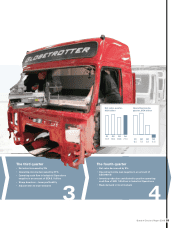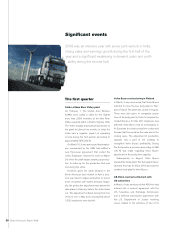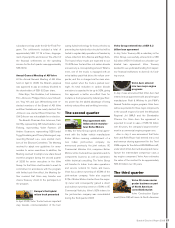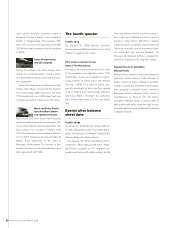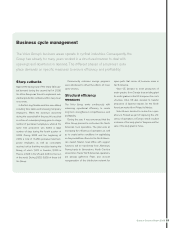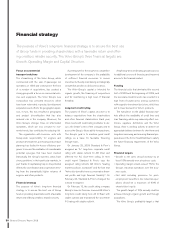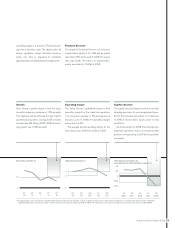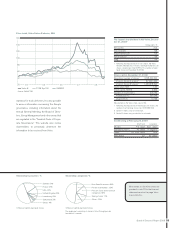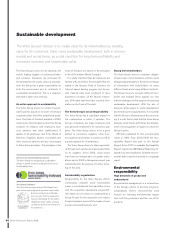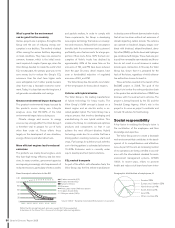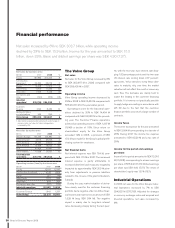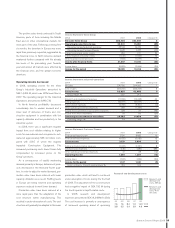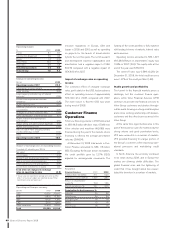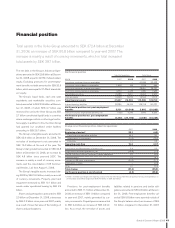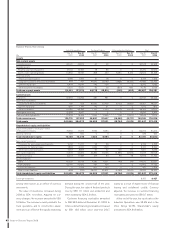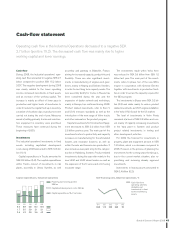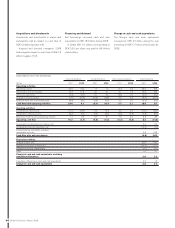Volvo 2008 Annual Report Download - page 39
Download and view the complete annual report
Please find page 39 of the 2008 Volvo annual report below. You can navigate through the pages in the report by either clicking on the pages listed below, or by using the keyword search tool below to find specific information within the annual report.
Emissions regulations for trucks and buses
US 10, 2010
US 07, 2007
0,16
0,14
0,12
0,10
0,08
0,06
0,04
0,02
0,00
Particles, g/kWh
NOx, g/kWh
012345678
Euro II, 1996
Euro III, 2002
Euro IV, 2006
Euro V, 2009
US 02, 2002 The currently applicable emissions standards are Euro IV
in Europe and US 07 in North America. The difference
between Euro III and Euro IV is considerable. Emissions of
particles have been reduced by 80%, and of NOx, by 30%.
During 2009, emission regulations will be lowered further
with the Euro V implementation. Euro V will entail a 50%
reduction of NOx emissions compared to Euro IV.
1) NOx value measured according to ECT.
Euro VI, 20131)
Guidance and control in the environ-
mental area
One of the most important elements for guid-
ance of environmental issues at the Volvo
Group is the common environmental policy.
The policy forms the basis for the Group’s envi-
ronmental management systems, strategies,
goals, audits and actions.
The environmental policy states that environ-
mental efforts shall be marked by a holistic
view, continuous improvements, technical
innovation and effi cient use of resources. The
policy is, in turn, divided into strategies and
goals for the organization.
The fi rst environmental management sys-
tem was certifi ed already in 1995. At the end
of 2008, 96% of the employees worked in
production units in accordance with certifi ed
environmental management systems, primarily
ISO 14001:2004. Other aspects of the value
chain – such as product development and
marketing – also have management systems.
Most employees work in operations that have
quality management systems certifi ed in
accordance with ISO 9001:2000.
The Group’s environmental goals are used
to monitor the entire organization, and they are
closely linked to business plans. The environ-
mental goals can be summarized through the
following challenges.
Production goals include:
• Reducing energy consumption by 50% per
unit manufactured by 2008, compared with
2003. The energy consumption per unit manu-
factured decreased by 43%.
• Doubling the use of CO2-neutral energy by
2008, compared with 2003. The use of CO2-
neutral energy has increased from approxi-
mately 100 GWh to some 300 GWh.
• Discontinuing all use of oil and coal for the
heating of facilities. The use has been reduced
from 11 plants to 5 plants.
Product use goals include:
• Achieving high fuel effi ciency and low emis-
sions throughout the entire life cycle
• Making comparisons with the best
• Consistent implementation of activities to
become the industry leader
• Generating environmental data for follow-up
and communication during the development
of every new product
• Implementing a strategy for fuels of the future
• Including alternative fuels and alternative drive-
trains in the product portfolio.
The environmental program also includes
partners. Environmental requirements have
been used since 1996 as an integral com-
ponent of supplier evaluations and follow-up
of various purchasing organizations.
Requirements on facilities
All production units must meet Group-wide
minimum requirements regarding the use of
chemicals, energy consumption, emissions to
air and water, waste management, environ-
mental organization and improvement efforts.
If local laws and regulations are more compre-
hensive they must be followed. Since 1989,
environmental audits have been carried out to
ensure that all plants comply with the environ-
mental policy. Newly acquired companies and
properties are subjected to an examination of
environmental factors and risks.
All the Group’s production facilities have the
requisite environmental permits. In Sweden,
there are 16 facilities that require permits.
These permits encompass waste, noise and
emissions to air, ground and water. Three envi-
ronmental permits were renewed in 2008 and
no permits are due for renewal in 2009.
The existence of polluted land on the
Group's properties is cataloged every year.
This pollution generally has historic origins. In
2008, cleaning-up activities were conducted
on two properties.
No major environmental incidents occurred
in 2008 and no environmental disputes took
place.
The Volvo Group’s operations generate
transport to and from the plants. These fl ows
are continuously reviewed to identify potential
improvement measures to reduce environmen-
tal impact.
35
Board of Directors’ Report 2008


